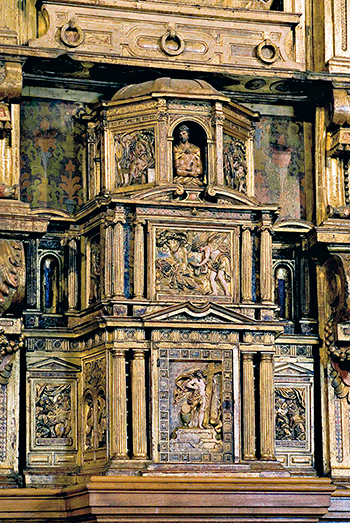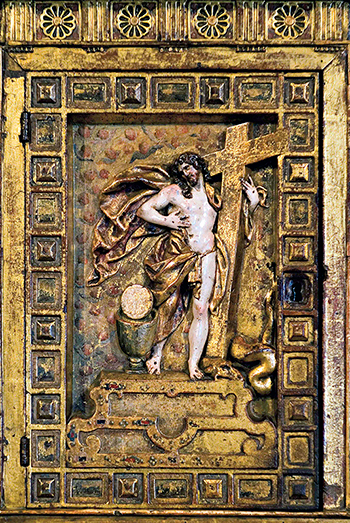The Romanist sculptor Juan de Anchieta
By Pedro Luis Echeverría Goñi
|
|
MAIN ALTARPIECE OF THE PARISH CHURCH OF SANTA MARÍA DE CÁSEDA |
|
|
|
|
|
|
|
|
|

|
|

|
|

|
|

|
Main altarpiece and tabernacle of Santa María of Tafalla
Although he could not see it finished, this monumental altarpiece, designed by Juan de Anchieta, is the pinnacle of Michelangelo's Romanesque style in Navarre. As on other occasions, the master of the gouge first contracted in 1581 for the tabernacle, which he would complete in 1583, estimating its value at 260 ducats. The patrons would commission him five years later for the altarpiece, which he could only begin, as he would die that same year of 1588. His widow and heir continued the work with the financial aid of Pedro González de San Pedro, who in 1589 became personally in charge of the work, which was valued in 1592 at the high sum of 5,114 ducats. The sculptor of Cabredo, one of his best disciples, followed the original design and the models and fragments of arms, legs and faces in clay and plaster and wax of the master, which the widow gave him in payment for his services, as documented by M.ª J. Tarifa. The achievements of the carving are enhanced in Tafalla with the accurate polychromy of the natural, applied by Juan de Landa, his head painter, in two phases, in 1596 and between 1599 and 1601.
The layout designed by the sculptor from Guipuzcoa places us before an architectural machine with clear lines that integrates much sculpture and ornamentation. It is a Mannerist altarpiece-façade, with two sections and five lanes, whose horizontality is only interrupted by the ascension of the attic, plagued by curved avoluted pediments with recumbent ephebos. In this work we find all subject of variants and licenses that prelude the Baroque, as the double bench with a sotabanco with ovals and squares separated by foliated mensulones. The inversion of mannerist elements means that pilasters with triglyphs are used instead of the capital not only in the attic, as in Astorga, but also in the first body. The circle has been Closed here with the use in the second section of columns with shafts covered with foliage, as in the Astorga altarpiece, where it had begun under the orders of Becerra. But the most novel solution is the stepped attic, modified at the request of the appraisers in 1592, in which we see above the curved pediment divided into volutes, the attic of the Descent from the Cross with a triangular pediment. It reminds us of works such as the façade of the church of the Redeemer in Venice, where Palladio superimposed four pediments. On the sides, two elevated podiums serve as seats for Moses and David. The praying Assumption, derived from Rachel of the Tomb of Julius II, is sheltered in a serliana and framed, like the Marian figures of the altarpieces of Briviesca and the cathedral of Burgos.
Anchieta's hand has left us his best works on the benches within reach of all those who want to enjoy these reliefs of international Mannerism. In the sotabanco a synthetic cycle of Mary's life is developed, with the four decisive episodes in the history of redemption: the Nativity of Mary, Annunciation, Visitation and Birth of Jesus, highlighting the two nativities in oval frames. The Nativity is related to an engraving of the same topic by Cornelis Cort, from the collection of El Escorial, while the Annunciation, an iconography very repeated by the master, will create a school in Navarre with a multitude of replicas, using drawings by Michelangelo through engravings such as the one by the French Nicolas Beatrizet. In two of the scenes, the angels fluttering in the upper part confer a sense of rhythm.
The ends of the predella are reserved for two dramatic moments of the end of the Passion, the Holy Burial and the Lamentation over the dead Christ, while on both sides of the expositor we see two stories that confirm the Resurrection of Christ: The Three Marys before the Sepulcher and The visit of Peter and John to the Sepulcher, in this case included in ovals. The first two reliefs denote his training in Valladolid with Juni and his knowledge of the programs of study for Michelangelo's Piedades. Thus, the way Christ lays his head on his left shoulder in the Burial is identical to those of Florence or Palestrina. In this scene there are quotation several expressions of pain and other Michelangelo's prototypes are copied, such as the Moses.
In the first body, it bears the imprint of the brilliant sculptor the bulk of the Savior, the primitive patron of the temple, represented as the risen Christ, topic star of the Counter-Reformation, with a monumental cross in the form of a tau that protrudes from its box. This Michelangelesque work is inspired by an engraving by Cherubino Alberti, from the El Escorial collection. The magnificent anatomical study of the nude, similar to that of the Crucified of the Miserere, is partially covered by the mantle of agreement with the Tridentine decorum. As the Savior of the World he appears blessing and accompanied by the orb, which stands out in the foreground on his right and a skull on his left as the conqueror of death.
The tabernacle-exhibitor of Tafalla, which serves to reserve and show the Sacred Form, is a consequence of the decree on the sacrament of the Eucharist of the Council of Trent in 1551. Its origin is in the scenographic tabernacle of three floors and lantern that Gaspar Becerra had designed as a "separate thing and member of itself", although integrated in the altarpiece of the cathedral of Astorga, which Juan de Anchieta could see there. It is exceptional that this classicist micro-building has been preserved complete with its original polychromy, which reminds us of a Roman temple and, very particularly, of the models shown in the museums of some Italian cathedrals. It adopts a semi-hexagonal plan with wings and three bodies, of which the first, called 'reliquary', is the container of the Sacred Form, and the last, covered with a dome, was conceived as an expositor. Its lexicon is Michelangelesque with double columns and superposition of orders, Tuscan, Ionic and Corinthian pilasters with their respective entablatures. Its gilded and estofado was contracted in 1596 to the painter Juan de Landa, who disassembled and polychromated it in Obanos. Among the few complete tabernacles of this type preserved in Navarre, those of Sesma and Ciriza stand out.
The rich Eucharistic iconographic program is presided over on the door by the Michelangelesque relief of the Risen Christ with the chalice and the Form, which served as model for the carving of the Savior, changing the allegories. He is escorted by the evangelists and in the wings, the Wedding at Cana and the Holy Supper. In the other bodies we find the usual prefigurations of the Old Testament, such as Elijah being fed by an angel, between the offering of Abraham and Melchizedek and David receiving the loaves, on the second floor. Finally, flanking the bust of Ecce Homo on the third floor are the reliefs of the Sacrifice of Isaac and Isaac carrying the wood.
CABEZUDO ASTRAIN, J., "Church of Santa María de Tafalla", Príncipe de Viana, 67-68 (1957), pp. 426-431.
CAMÓN AZNAR, J., El escultor Juan de Anchieta, San Sebastián, Diputación Foral de Guipúzcoa, 1943.
ECHEVERRÍA GOÑI, P. L. and VÉLEZ CHAURRI, J. J., "López de Gámiz and Anchieta compared. Las claves del Romanismo norteño", Príncipe de Viana, 185 (1988), pp. 477-534.
GARCÍA GAINZA, M.ª C., "El retablo de Añorbe y el arte de la Contrarreforma", in La recuperación de un patrimonio. El retablo mayor de Añorbe, Pamplona, Caja de Ahorros de Navarra, 1995, pp. 4-18.
GARCÍA GAINZA, M.ª C., Juan de Anchieta, sculptor of the Renaissance, Madrid, Fundación Arte Hispánico, 2008.
GARCÍA GAINZA, M.ª C., La escultura romanista en Navarra. Disciples and followers of Juan de Anchieta, 2nd ed., Pamplona, Government of Navarra, 1982.
GOYENECHE VENTURA, M.ª T., "La obra de Juan de Anchieta en la iglesia parroquial de Santa María de Cáseda (Navarra)", Príncipe de Viana, 185 (1988), pp. 535-562.
TARIFA CASTILLA, M.ª J., "Los modelos y figuras del escultor romanista Juan de Anchieta", in Fernández Gracia, R. (coord..), Pvlchrvm Scripta varia in honorem M.ª Concepción García Gainza, Pamplona, Gobierno de Navarra-Universidad de Navarra, 2011, pp. 782-790.
VASALLO TORANZO, L., Juan de Anchieta. Aprendiz y oficial de escultura en Castilla (1551-1571), Valladolid, Universidad de Valladolid, Secretariado de Publicaciones e exchange publishing house , 2012.







